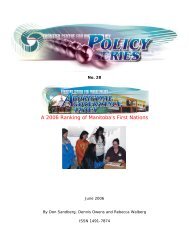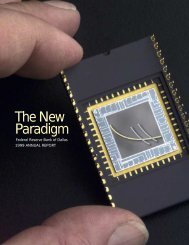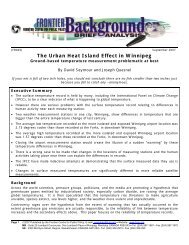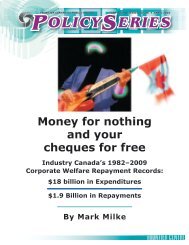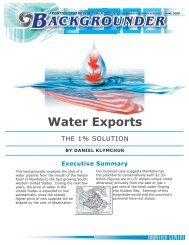You also want an ePaper? Increase the reach of your titles
YUMPU automatically turns print PDFs into web optimized ePapers that Google loves.
(FB006) OCTOBER 2001<br />
<strong>SCHOOL</strong> <strong>CHOICE</strong>, <strong>KIWI</strong>-<strong>STYLE</strong><br />
When New Zealand Abolished School Boards<br />
FOREWORD<br />
By Matthew Ladner and Maurice McTigue<br />
The structure of Manitoba’s system of public school governance, in place <strong>for</strong> most of the last century,<br />
continues to lose favour with the public and with key decision-makers. The Mayor of Winnipeg and the<br />
provincial Minister of Education have opened a public discussion about fundamental changes to that structure.<br />
They both recommend more centralization, in particular the amalgamation of existing school divisions into<br />
larger units. The Mayor, in fact, calls <strong>for</strong> the consolidation of all Winnipeg divisions and their governing boards<br />
into a single entity responsible <strong>for</strong> the whole metropolitan area. The following discussion presented here<br />
points out that another choice is available.<br />
In New Zealand, the public school system suffered from the same ills that beset ours, weak lines of<br />
accountability, high costs, low productivity and declining academic standards. Instead of centralizing and<br />
arguably concentrating these problems, authorities decided to move in the other direction. They perceived<br />
that school boards were essentially functioning as expensive middlemen, adding little of value and providing a<br />
cover <strong>for</strong> those who really controlled the budgets and standards in public schools. They moved instead to a<br />
system of school-based management which allows principals, teachers and parents to make crucial decisions<br />
about allocating resources and holds them accountable <strong>for</strong> results. – Dennis Owens, Senior <strong>Policy</strong> Analyst<br />
THE NEW ZEALAND EDUCATION REFORMS<br />
As in most jurisdictions in North America, including Manitoba, New Zealand was grappling with major policy<br />
questions about education, from improving student per<strong>for</strong>mance to funding <strong>for</strong>mulas, from charter schools to<br />
classroom size. More than a decade ago, New Zealand, a country with a population about the size of the<br />
average American state, faced problems similar to those in Canadian public schools, rapidly expanding costs<br />
and declining per<strong>for</strong>mance. The Kiwis made bold, across-the-board re<strong>for</strong>ms, with positive results.<br />
New Zealand's government had created a massive, unresponsive educational system where parents had little<br />
or no influence. The system was failing to meet acceptable achievement levels. There was outright<br />
bureaucratic capture, and little or no per<strong>for</strong>mance accountability. The system consumed 70 cents of every<br />
education dollar, with only 30 cents spent in the classroom. As in Canada, budget figures underestimated<br />
these overheads; what were officially described as “administration costs” represented a convenient fiction.<br />
The New Zealand government administered education through a highly bureaucratic structure. The Ministry of<br />
Education, the central body that answered to the federal government, made all of the rules and controlled<br />
expenditures with prescriptive regulations. It determined the curriculum, how it would be taught, and how<br />
per<strong>for</strong>mance would be measured. In every region, the ministry established Boards of Education to whom it<br />
delegated limited power.<br />
Since re<strong>for</strong>ms were implemented, about 67 cents of each education dollar is now spent in the classroom, more<br />
than double the previous amount. Parents play the dominant role in the educational choices <strong>for</strong> their children.<br />
Learning has improved, and classroom size is down.<br />
Education continues to be fully funded by the central government from general income and consumption tax<br />
revenues. Every child is still entitled by law to a tax-supported education until completing secondary school.<br />
Little else remains the same.<br />
Page 1<br />
©2001 Published by the <strong>Frontier</strong> <strong>Centre</strong> <strong>for</strong> <strong>Public</strong> <strong>Policy</strong>, 201-63 Albert Street • Winnipeg, Manitoba CANADA R3B 1G4<br />
•Tel: (204) 957-1567 Fax: (204) 957-1570 • E-mail: newideas@fcpp.org • Website: www.fcpp.org
THE MIDDLEMAN STEPS OUT<br />
Comprehensive re<strong>for</strong>m in New Zealand reversed<br />
the top-down style of governance. All Boards of<br />
Education have been eliminated. Boards of<br />
Trustees have been established <strong>for</strong> each school.<br />
Parents of the children at that school run <strong>for</strong><br />
election to boards, which are unpaid positions.<br />
The Trustees deliver accountability directly into<br />
the hands of the parents. The Board of Trustees<br />
makes all spending decisions, and has full<br />
responsibility <strong>for</strong> what happens at their school.<br />
The Board of Trustees writes the Charter <strong>for</strong> their<br />
school, and is bound by and accountable <strong>for</strong><br />
achieving its goals. The Charter can only be<br />
changed after a consultative process with the<br />
parents.<br />
The role of the Ministry has been changed to that of the body that passes to the Board of Trustees a block of<br />
money determined by a <strong>for</strong>mula based on the number of students at the school. It is also responsible <strong>for</strong><br />
auditing school per<strong>for</strong>mance against its Charter requirements. Reflecting its new role, the Ministry was<br />
reduced to about half its <strong>for</strong>mer size.<br />
Because education is the most important influence on a child's future, next to parenting, New Zealanders<br />
participated in a significant debate over parental rights regarding education. They decided that parents have<br />
an absolute right to choose the school at which their children will be educated. The consequence: good schools<br />
with good teachers get more students, less capable schools with less capable teachers get fewer students,<br />
which means that less money and fewer teachers are employed at that school.<br />
Private schools may get state funding equivalent to public schools. To do so they must make an application to<br />
the Minister of Education to integrate. This process requires them to prove their buildings, grounds and<br />
facilities meet code standards. About 15 percent of all schools are private, and to date about 90 percent of<br />
these schools have integrated.<br />
Once integrated, private schools have the right to maintain their special character (normally religious<br />
education and ethics), though they must teach the core curriculum and be open and actively teaching the<br />
students <strong>for</strong> a prescribed number of days each school year. For this they get identical funding to public<br />
schools, including capital funding. They may compete to educate any children. This process started in the<br />
1970's, and is now non-controversial.<br />
The elimination of bureaucracy freed up large quantities of money, and the national government decided that<br />
all of it would remain a part of education spending. This decision allowed major investments in classroom<br />
technology, a significant investment in teaching aides and bringing all maintenance projects up to date.<br />
80%<br />
60%<br />
40%<br />
20%<br />
0%<br />
Figure 1: New Zealand Education Spending-<br />
Reaching the Classroom<br />
70%<br />
33%<br />
67%<br />
30%<br />
Pre-re<strong>for</strong>ms Post-re<strong>for</strong>ms<br />
Administrative<br />
Costs<br />
Classroom<br />
Spending<br />
IMPROVED TEST SCORES VALIDATE THE REFORMS<br />
The Third International Mathematics and Science Examination gave international achievement tests to<br />
samples of students in multiple countries. Students were tested in the 4 th , 8 th and 12 th grades. The figures<br />
below present 1995 mathematics achievement scores <strong>for</strong> the United States and New Zealand compared to the<br />
international average.<br />
Achievement scores are influenced by a variety of factors other than the quality of schools. For instance, New<br />
Zealand introduces mathematics and science into the curriculum at later grades than is commonly the case.<br />
Although this curriculum severely handicaps the per<strong>for</strong>mance of New Zealand’s 4 th grade students on<br />
international exams, it is ultimately of no real consequence.<br />
The influence of school quality, however, increases as a student spends more time in the school system.<br />
Idiosyncratic factors have largely played themselves out by the graduating year. The 12 th Grade tests are<br />
ultimately more important than earlier ones, reflecting the quality of skills held by students entering college<br />
and the work<strong>for</strong>ce.<br />
The 1995 Mathematics TIMSS exams reveal that New Zealand 4 th graders start 30 points below the<br />
international average, but they quickly catch up, with 8 th graders being only 5 points below the international<br />
average, and 12 th graders scoring 22 points above the international average. Obviously, once mathematics<br />
has been introduced, the lessons are learned well in New Zealand.<br />
Page 2 ©2001 Published by the <strong>Frontier</strong> <strong>Centre</strong> <strong>for</strong> <strong>Public</strong> <strong>Policy</strong>, 201-63 Albert Street • Winnipeg, Manitoba CANADA R3B 1G4<br />
•Tel: (204) 957-1567 Fax: (204) 957-1570 • E-mail: newideas@fcpp.org • Website: www.fcpp.org
Figure 2: New Zealand 4th, 8th and 12th<br />
Grade Math TIMSS (International<br />
Average=0)<br />
Figure 3: U.S. 4th, 8th and 12th Grade<br />
Math TIMMS (International Average=0)<br />
20<br />
16<br />
30<br />
20<br />
10<br />
0<br />
-10<br />
-20<br />
-5<br />
22<br />
4th Grade<br />
8th Grade<br />
12th Grade<br />
10<br />
0<br />
-10<br />
-20<br />
-30<br />
-13<br />
4th Grade<br />
8th Grade<br />
12th Grade<br />
-30<br />
-40<br />
-30<br />
-40<br />
-50<br />
-39<br />
Un<strong>for</strong>tunately, North American scores show the opposite pattern. While American 4 th graders score 16 points<br />
above the international average, American 8 th graders score 13 points below the international average.<br />
Finally, American 12 th graders scored 39 points below the international average. Evidently, the longer<br />
American students spend in our schools, the further they fall behind students from our competitor nations.<br />
Canadian test results are only marginally better.<br />
WHAT ABOUT THE CRITICS?<br />
Defenders of the status-quo in North America sometimes venture overseas to misrepresent how school choice<br />
works abroad. A recent book on New Zealand is a classic of the genre. Can school re<strong>for</strong>mers here learn<br />
lessons from the history of school re<strong>for</strong>m in New Zealand? Undoubtedly yes, but they should take care to get<br />
their facts straight first. When Schools Compete: A Cautionary Tale, by American authors Edward Fiske and<br />
Helen Ladd, provides an overview of education re<strong>for</strong>m in New Zealand which seems selective at best and<br />
deceptive at worst. Worse still, the authors have attempted to apply “lessons” from New Zealand to re<strong>for</strong>m<br />
proposals here while misinterpreting what lessons we should actually draw.<br />
As an exercise in comparative politics, the book is interesting. Fiske and Ladd begin by rightly noting that<br />
New Zealand roughly compares to a median American state, say, Kentucky, and that New Zealand has<br />
minority populations, primarily Maori and Pacific Islanders, who are less prosperous on average than the<br />
majority Caucasian population. The authors also note that New Zealand has been experimenting with neoliberal<br />
education policy re<strong>for</strong>m longer and more thoroughly than any of our states, suggesting that we may<br />
have things to learn from the Kiwi experience.<br />
The authors spent five months in New Zealand examining the new competitive culture of the New Zealand<br />
education system and note repeatedly that the re<strong>for</strong>ms enjoy a great deal of public support in New Zealand<br />
that make it very unlikely that they will be repealed, a fact that seems to have been under-appreciated.<br />
Nevertheless, the authors raise concerns that they ultimately find troubling <strong>for</strong> competition-based models of<br />
education re<strong>for</strong>m in general.<br />
First, the authors empirically establish a tendency among Kiwi parents to favor schools with higher income<br />
students than those with lower income students. From this, they raise concerns about an increase in<br />
economic segregation in New Zealand schools. This problem was initially exacerbated by enrollment<br />
regulations allowing schools operating at capacity to draw up their own criteria <strong>for</strong> enrollment. This<br />
enrollment regime may have allowed highly sought after schools to “skim the cream” among applicant families<br />
by allowing schools to accept only desirable students. The result of this, the authors argue, is that the<br />
parental choice plan in New Zealand degenerated into a school choice plan in which the schools did the<br />
choosing rather than the parents.<br />
This claim of skimming serves as the crux of the book’s argument. In a radio interview promoting the book,<br />
the interviewer asked Fiske and Ladd whether Americans hadn’t anticipated the potential “skimming” problem.<br />
The interviewer noted that charter schools, <strong>for</strong> instance, typically require random admission procedures <strong>for</strong><br />
charter schools. The answers provided by the authors seem telling. First Fiske responded: “You would<br />
probably not be able to sustain that under a voucher system where you were allowing students to go to<br />
private or religious schools because they would certainly not surrender the right to determine who their<br />
students would be.”<br />
Page 3<br />
©2001 Published by the <strong>Frontier</strong> <strong>Centre</strong> <strong>for</strong> <strong>Public</strong> <strong>Policy</strong>, 201-63 Albert Street • Winnipeg, Manitoba CANADA R3B 1G4<br />
•Tel: (204) 957-1567 Fax: (204) 957-1570 • E-mail: newideas@fcpp.org • Website: www.fcpp.org
Then Ladd followed: “Nor could you maintain that [random admission policies] if charter schools became the<br />
norm in contrast to representing schools on the fringe of the traditional education system.”<br />
These statements may reflect the political agendas of the authors, but they do not reflect the reality of North<br />
America’s experience with choice. The degree of “skimming” in New Zealand is open to differing<br />
interpretations. For instance, many schools sought to specialize after the advent of competition, not unlike<br />
themed charter schools in the United States and Alberta, the only Canadian province that allows charter<br />
schools. Some specialized in music or the visual arts, others in science; some targeted children with above<br />
average intelligence, others focussed on the handicapped. A number of schools in New Zealand chose to<br />
specialize in Maori culture. Maori families who send their children to Maori-themed schools might create the<br />
appearance of “skimming” and segregation, but it would be quite a stretch to describe such choices as<br />
undesirable.<br />
Leaving such considerations aside, the ultimate importance to North American readers involves the<br />
applicability of the New Zealand experience to Canada and the United States. There is no need to speculate<br />
on how voucher programs would operate with regard to “skimming” because there is plenty of empirical<br />
evidence. Private schools have accepted random lotteries <strong>for</strong> admission of students. <strong>Public</strong>ly funded voucher<br />
programs in the United States, <strong>for</strong> example, have been <strong>for</strong> the exclusive benefit of very low-income children.<br />
The oldest voucher program, the Milwaukee Parental Choice Program (MPCP), <strong>for</strong> example, serves a student<br />
population in which 54 percent of families receive welfare, and with an average income is $11,600. Single<br />
parents head 76 percent of MCPC by a single parent, and more than 96 percent of MCPC students are<br />
minorities. The vast majority of publicly and privately funded voucher proposals have been aimed explicitly at<br />
low-income children in low-quality public schools.<br />
DOES <strong>SCHOOL</strong> <strong>CHOICE</strong> ACCELERATE RACIAL SEGREGATION?<br />
Fiske and Ladd express concerns about racial segregation in their book. Recent studies in the United States,<br />
however, have found private schools are actually better racially integrated than public schools, as public<br />
schools rely on segregated housing patterns. Whites are typically concentrated in suburbs and minority<br />
populations concentrated in urban school systems. <strong>Public</strong> schools tend to be very segregated because they<br />
rely on these segregated housing patterns. Private schools have been found to be less racially segregated<br />
than public schools simply because they draw upon students from larger geographic areas. A major inhibitor<br />
of greater diversity in private schools is the difficulty of many parents to pay <strong>for</strong> both public school taxes and<br />
private school tuition.<br />
Ultimately, New Zealand has the means to prevent skimming in choice programs, and has already employed<br />
them. New Zealand initially chose not to make use of such tools, but promptly changed course. Choice<br />
re<strong>for</strong>mers in the United States have already anticipated the possibility of “skimming” and have taken<br />
precautions against it.<br />
WINNERS AND LOSERS<br />
Fiske and Ladd ultimately express the most concern regarding choice-based re<strong>for</strong>ms based on the fact that<br />
there have been schools that have “lost” in the competitive environment. Fiske and Ladd argue that<br />
competition inherently involves winners and losers, and they then proceed to fret about the “losing” schools.<br />
The authors either misunderstand the nature of competition, or else they have employed a logical slide.<br />
Commentators often describe international trade as “competition” between nations, and economists<br />
demonstrated long ago that such competition benefits all participants. Sport leagues involve athletic<br />
competition, but no one proposes eliminating baseball or soccer games because individual games produce a<br />
victor. The idea behind athletic competition, and indeed the reason such competition is included as a part of<br />
schools, is that the process of competition will improve and benefit all participants.<br />
Fiske and Ladd argue that competition has not improved schools losing enrollments as a result of the re<strong>for</strong>ms.<br />
Many of these “defeated schools” serve primarily low-income and disproportionately minority populations. The<br />
main failing of the book, however, is that the authors fail to muster any evidence whatsoever that the children<br />
in these schools have in fact suffered the least bit of harm. The authors express concern about the plight of<br />
schools unsuccessful in keeping their enrollment up, when in fact it is entirely possible that the children in<br />
those schools are learning more than they otherwise would have. This is a key empirical question, and a<br />
difficult one to address in the absence of a national testing program. The authors, however, fail to examine<br />
testing data that is available, such as international proficiency tests. Had the authors examined such<br />
in<strong>for</strong>mation, they would have found an academic record that any jurisdiction in North America would be<br />
thrilled to have (see Figures 2 and 3 above). Likewise, a politician in North America who managed to more<br />
than double the amount of school spending that reaches the classroom, while reducing bureaucracy, would be<br />
hailed as a hero (see Figure 1 above). New Zealanders can take pride in such a record. While the authors<br />
Page 4<br />
©2001 Published by the <strong>Frontier</strong> <strong>Centre</strong> <strong>for</strong> <strong>Public</strong> <strong>Policy</strong>, 201-63 Albert Street • Winnipeg, Manitoba CANADA R3B 1G4<br />
•Tel: (204) 957-1567 Fax: (204) 957-1570 • E-mail: newideas@fcpp.org • Website: www.fcpp.org
imply that some students have been harmed by the re<strong>for</strong>ms, they fail to present even the smallest bit of<br />
evidence to that effect.<br />
THE LESSON: MAKE <strong>SCHOOL</strong> <strong>CHOICE</strong> UNIVERSAL<br />
Ironically, the cautionary lesson to be drawn from the New Zealand experience is to avoid school choice<br />
programs that include only public schools. The key problem with the New Zealand program lies in the fact<br />
that the government retained ownership over school facilities, and has been reluctant both to spend money<br />
expanding popular schools and to close unpopular schools. This is a problem <strong>for</strong> those who argue <strong>for</strong> keeping<br />
choice within the realm of public schools, not <strong>for</strong> those advocating full school choice. Such political<br />
considerations interfere with the functioning of the education market in New Zealand, but would be less of a<br />
problem under a full choice program. Private and charter schools in the North America can and do open,<br />
expand and close their doors, free of considerations about government capital support.<br />
The “cautionary tale” the authors see <strong>for</strong> competition models is the fact that some schools will gain students<br />
while others will lose them under competition. The authors, however, acknowledge that many of the schools<br />
having difficulty under the re<strong>for</strong>ms are the same schools that had trouble under the previous centralized<br />
regime. The authors have there<strong>for</strong>e mistaken a real gain of the re<strong>for</strong>ms <strong>for</strong> a problem. New Zealand schools<br />
esteemed by parents have grown, while unpopular schools have shrunk. What this means is that fewer Kiwi<br />
children today attend schools which parents regard as being of relatively low quality than was the case<br />
be<strong>for</strong>ethe re<strong>for</strong>ms. This is a victory to be celebrated rather than a failure of the re<strong>for</strong>ms.<br />
CONCLUSION<br />
Although not without its imperfections, school re<strong>for</strong>m in New Zealand has, as stated earlier, been quite<br />
successful, and is supported by a substantial majority of the population. Individual schools have much more<br />
control over the style and content of their offerings, and budget decisions reflect the values of educators and<br />
parents instead of the needs of politicians, bureaucrats and teachers’ unions.<br />
Post-re<strong>for</strong>m, the proportion of resources dedicated to front-line educating in New Zealand has doubled, while<br />
administrative layers have been peeled away. This change in priorities is reflected in New Zealand’s improved<br />
ranking in international test scores. If Canadians want to match this record, they ought to consider abolishing<br />
school boards, not making them larger and more powerful.<br />
About the authors:<br />
Dr. Matthew Ladner is director of communications and policy <strong>for</strong> Children First America, an education charity promoting<br />
school choice <strong>for</strong> low-income families in Bentonville, Arkansas. The Right Honourable Maurice McTigue is a distinguished<br />
visiting scholar at the Mercatus Center, a public policy think tank at George Mason University in Fairfax, Virginia. He was a<br />
Member of Parliament and held several Cabinet portfolios in the New Zealand Government between 1990 and 1993. He was<br />
also New Zealand’s ambassador to Canada from 1994 to 1997.<br />
The <strong>Frontier</strong> <strong>Centre</strong> <strong>for</strong> <strong>Public</strong> <strong>Policy</strong> is an independent public policy think tank whose mission is to explore options <strong>for</strong> the future by<br />
undertaking research and education that supports economic growth and opportunity. You can reach us at: 201-63 Albert Street • Winnipeg,<br />
Manitoba CANADA R3B 1G4 •Tel: (204) 957-1567 Fax: (204) 957-1570 • E-mail: newideas@fcpp.org • Website: www.fcpp.org<br />
Page 5<br />
©2001 Published by the <strong>Frontier</strong> <strong>Centre</strong> <strong>for</strong> <strong>Public</strong> <strong>Policy</strong>, 201-63 Albert Street • Winnipeg, Manitoba CANADA R3B 1G4<br />
•Tel: (204) 957-1567 Fax: (204) 957-1570 • E-mail: newideas@fcpp.org • Website: www.fcpp.org




